HRM 6113 Summer A-18: Workforce Planning - Case Studies & IBM Analysis
VerifiedAdded on 2023/06/12
|9
|1762
|412
Case Study
AI Summary
This assignment provides a comprehensive analysis of workforce planning through case studies of Bristol-Myers Squibb, Metro Transit, and IBM. The Bristol-Myers Squibb case focuses on improving general manager training through enhanced interpersonal skills and employee feedback integration. The Metro Transit case addresses recruitment and training program effectiveness, emphasizing the need for consistent performance monitoring and organizational development. The IBM analysis explores the company's diversity and inclusion initiatives, highlighting data leverage, cognitive technology implementation, and corporate citizenship programs. The assignment concludes by evaluating the applicability of IBM's diversity approach to smaller organizations, considering factors like corporate culture and strategic partnerships. This document is available on Desklib, where students can find a wide range of study resources, including solved assignments and past papers.

Running head: WORKFORCE PLANNING
Workforce planning
Name of student
Name of University
Author note
Workforce planning
Name of student
Name of University
Author note
Paraphrase This Document
Need a fresh take? Get an instant paraphrase of this document with our AI Paraphraser
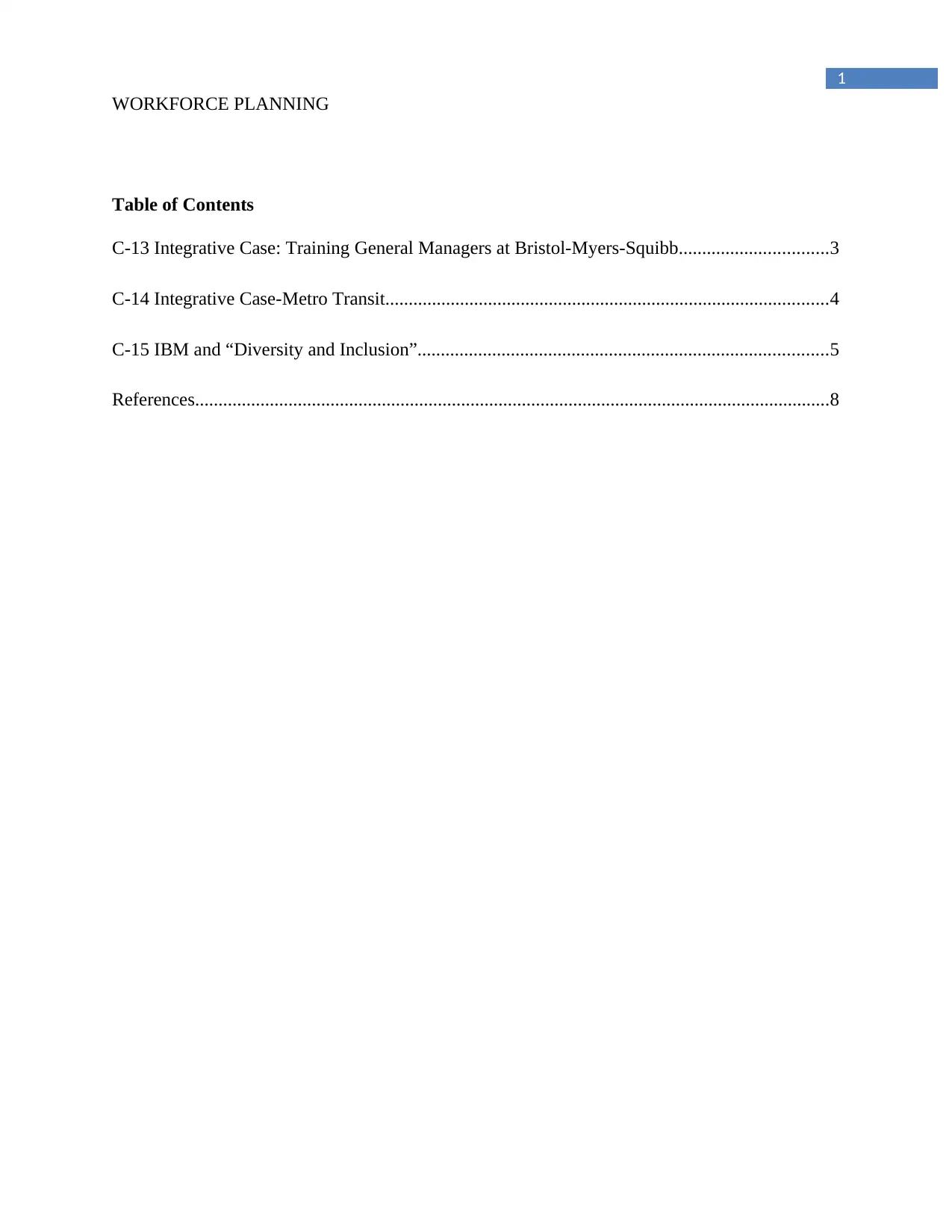
1
WORKFORCE PLANNING
Table of Contents
C-13 Integrative Case: Training General Managers at Bristol-Myers-Squibb................................3
C-14 Integrative Case-Metro Transit...............................................................................................4
C-15 IBM and “Diversity and Inclusion”........................................................................................5
References........................................................................................................................................8
WORKFORCE PLANNING
Table of Contents
C-13 Integrative Case: Training General Managers at Bristol-Myers-Squibb................................3
C-14 Integrative Case-Metro Transit...............................................................................................4
C-15 IBM and “Diversity and Inclusion”........................................................................................5
References........................................................................................................................................8
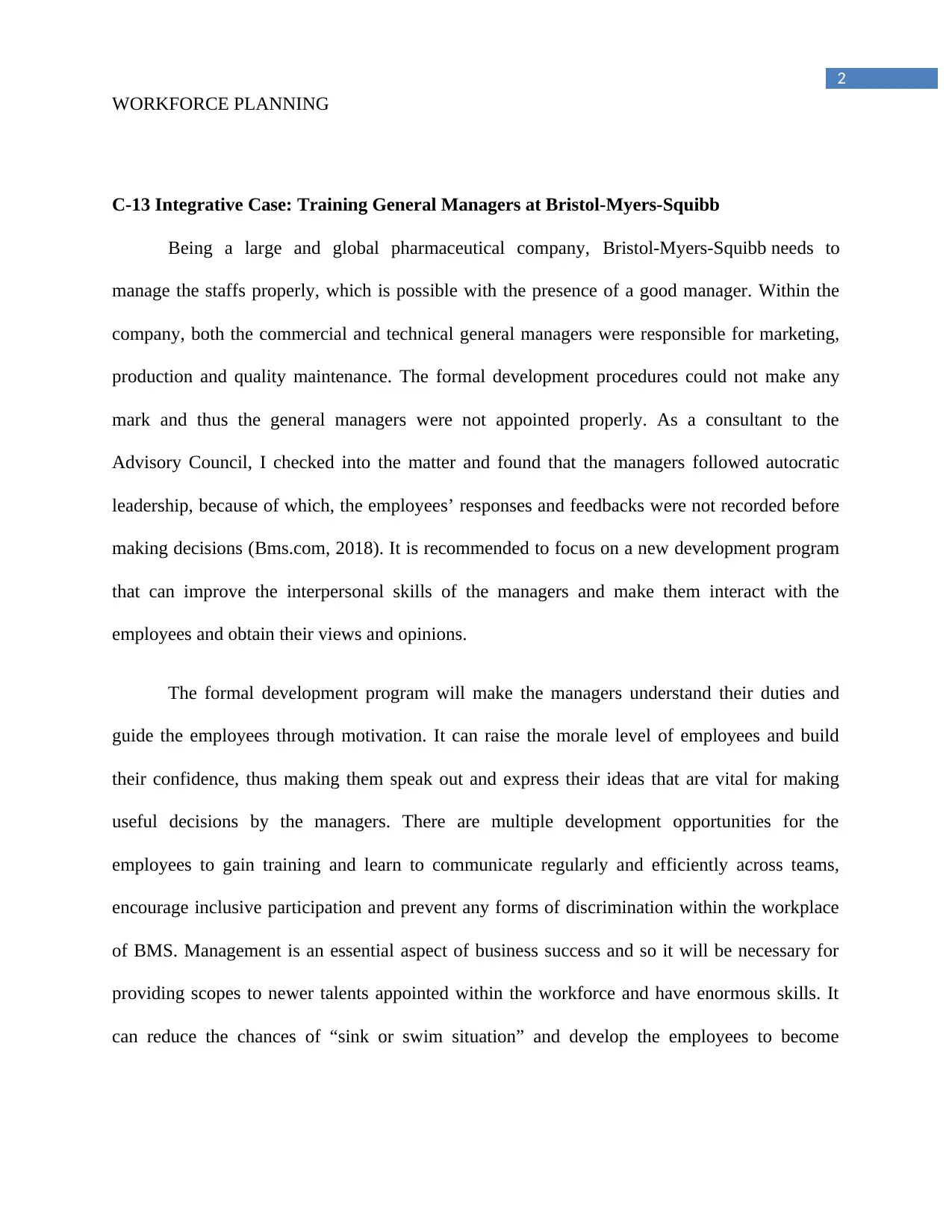
2
WORKFORCE PLANNING
C-13 Integrative Case: Training General Managers at Bristol-Myers-Squibb
Being a large and global pharmaceutical company, Bristol-Myers-Squibb needs to
manage the staffs properly, which is possible with the presence of a good manager. Within the
company, both the commercial and technical general managers were responsible for marketing,
production and quality maintenance. The formal development procedures could not make any
mark and thus the general managers were not appointed properly. As a consultant to the
Advisory Council, I checked into the matter and found that the managers followed autocratic
leadership, because of which, the employees’ responses and feedbacks were not recorded before
making decisions (Bms.com, 2018). It is recommended to focus on a new development program
that can improve the interpersonal skills of the managers and make them interact with the
employees and obtain their views and opinions.
The formal development program will make the managers understand their duties and
guide the employees through motivation. It can raise the morale level of employees and build
their confidence, thus making them speak out and express their ideas that are vital for making
useful decisions by the managers. There are multiple development opportunities for the
employees to gain training and learn to communicate regularly and efficiently across teams,
encourage inclusive participation and prevent any forms of discrimination within the workplace
of BMS. Management is an essential aspect of business success and so it will be necessary for
providing scopes to newer talents appointed within the workforce and have enormous skills. It
can reduce the chances of “sink or swim situation” and develop the employees to become
WORKFORCE PLANNING
C-13 Integrative Case: Training General Managers at Bristol-Myers-Squibb
Being a large and global pharmaceutical company, Bristol-Myers-Squibb needs to
manage the staffs properly, which is possible with the presence of a good manager. Within the
company, both the commercial and technical general managers were responsible for marketing,
production and quality maintenance. The formal development procedures could not make any
mark and thus the general managers were not appointed properly. As a consultant to the
Advisory Council, I checked into the matter and found that the managers followed autocratic
leadership, because of which, the employees’ responses and feedbacks were not recorded before
making decisions (Bms.com, 2018). It is recommended to focus on a new development program
that can improve the interpersonal skills of the managers and make them interact with the
employees and obtain their views and opinions.
The formal development program will make the managers understand their duties and
guide the employees through motivation. It can raise the morale level of employees and build
their confidence, thus making them speak out and express their ideas that are vital for making
useful decisions by the managers. There are multiple development opportunities for the
employees to gain training and learn to communicate regularly and efficiently across teams,
encourage inclusive participation and prevent any forms of discrimination within the workplace
of BMS. Management is an essential aspect of business success and so it will be necessary for
providing scopes to newer talents appointed within the workforce and have enormous skills. It
can reduce the chances of “sink or swim situation” and develop the employees to become
⊘ This is a preview!⊘
Do you want full access?
Subscribe today to unlock all pages.

Trusted by 1+ million students worldwide
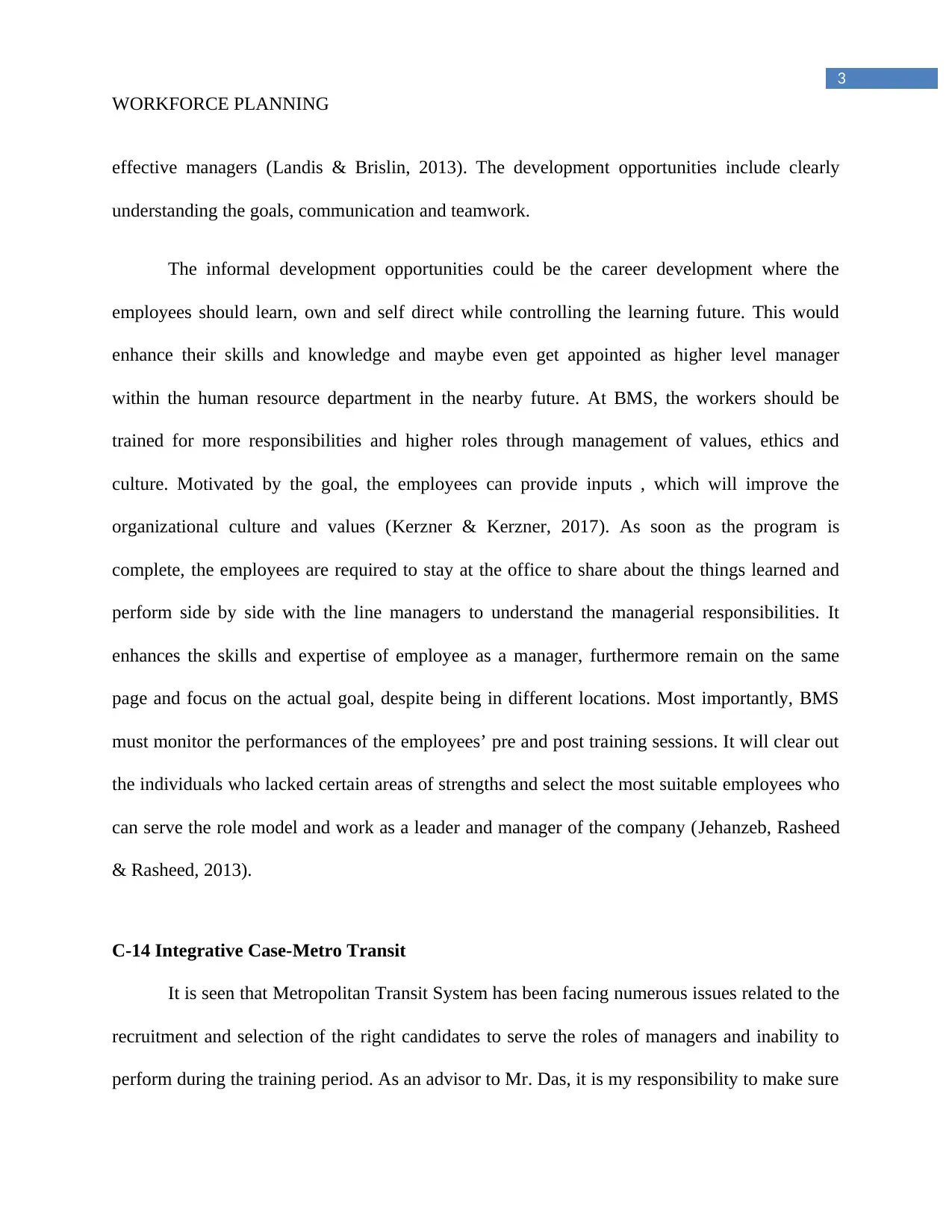
3
WORKFORCE PLANNING
effective managers (Landis & Brislin, 2013). The development opportunities include clearly
understanding the goals, communication and teamwork.
The informal development opportunities could be the career development where the
employees should learn, own and self direct while controlling the learning future. This would
enhance their skills and knowledge and maybe even get appointed as higher level manager
within the human resource department in the nearby future. At BMS, the workers should be
trained for more responsibilities and higher roles through management of values, ethics and
culture. Motivated by the goal, the employees can provide inputs , which will improve the
organizational culture and values (Kerzner & Kerzner, 2017). As soon as the program is
complete, the employees are required to stay at the office to share about the things learned and
perform side by side with the line managers to understand the managerial responsibilities. It
enhances the skills and expertise of employee as a manager, furthermore remain on the same
page and focus on the actual goal, despite being in different locations. Most importantly, BMS
must monitor the performances of the employees’ pre and post training sessions. It will clear out
the individuals who lacked certain areas of strengths and select the most suitable employees who
can serve the role model and work as a leader and manager of the company (Jehanzeb, Rasheed
& Rasheed, 2013).
C-14 Integrative Case-Metro Transit
It is seen that Metropolitan Transit System has been facing numerous issues related to the
recruitment and selection of the right candidates to serve the roles of managers and inability to
perform during the training period. As an advisor to Mr. Das, it is my responsibility to make sure
WORKFORCE PLANNING
effective managers (Landis & Brislin, 2013). The development opportunities include clearly
understanding the goals, communication and teamwork.
The informal development opportunities could be the career development where the
employees should learn, own and self direct while controlling the learning future. This would
enhance their skills and knowledge and maybe even get appointed as higher level manager
within the human resource department in the nearby future. At BMS, the workers should be
trained for more responsibilities and higher roles through management of values, ethics and
culture. Motivated by the goal, the employees can provide inputs , which will improve the
organizational culture and values (Kerzner & Kerzner, 2017). As soon as the program is
complete, the employees are required to stay at the office to share about the things learned and
perform side by side with the line managers to understand the managerial responsibilities. It
enhances the skills and expertise of employee as a manager, furthermore remain on the same
page and focus on the actual goal, despite being in different locations. Most importantly, BMS
must monitor the performances of the employees’ pre and post training sessions. It will clear out
the individuals who lacked certain areas of strengths and select the most suitable employees who
can serve the role model and work as a leader and manager of the company (Jehanzeb, Rasheed
& Rasheed, 2013).
C-14 Integrative Case-Metro Transit
It is seen that Metropolitan Transit System has been facing numerous issues related to the
recruitment and selection of the right candidates to serve the roles of managers and inability to
perform during the training period. As an advisor to Mr. Das, it is my responsibility to make sure
Paraphrase This Document
Need a fresh take? Get an instant paraphrase of this document with our AI Paraphraser
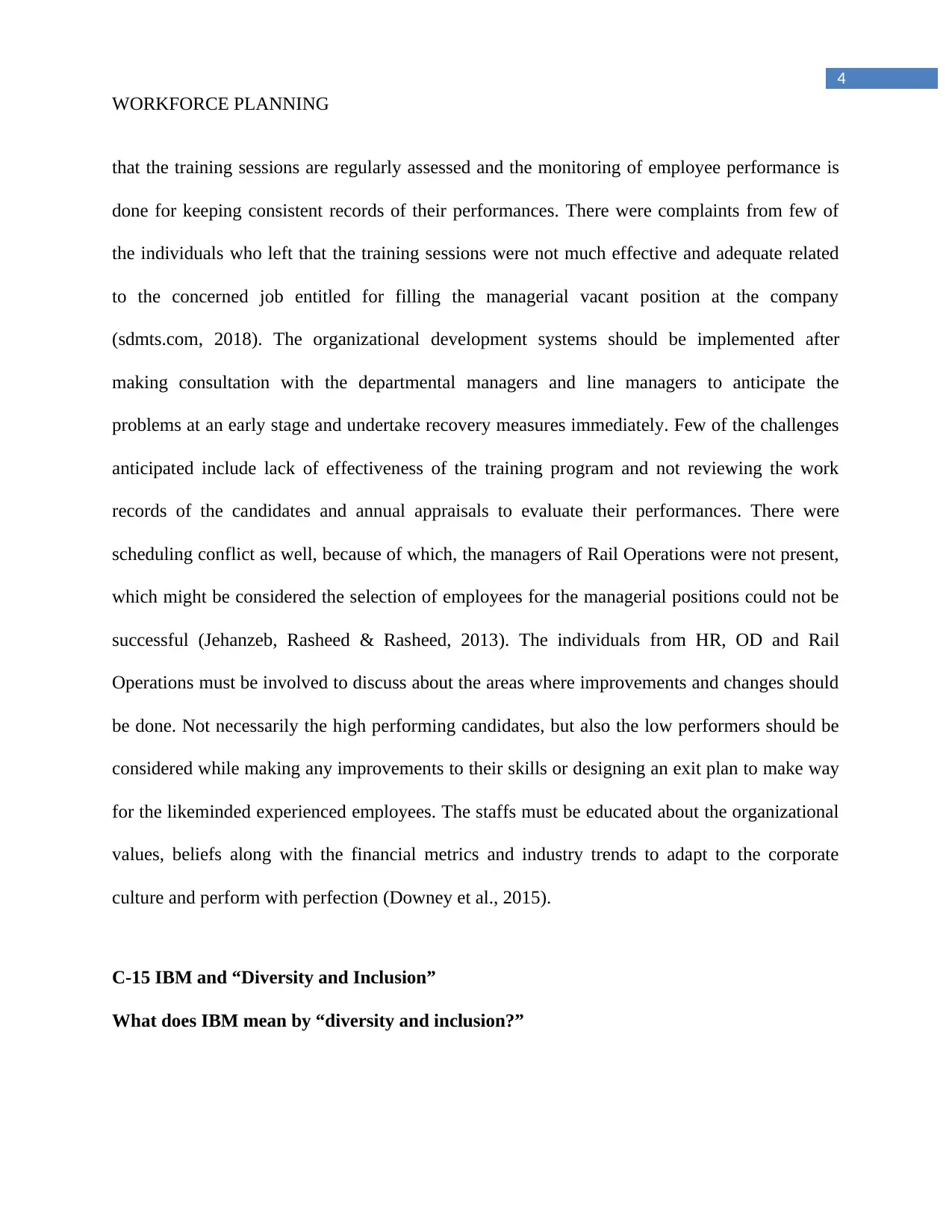
4
WORKFORCE PLANNING
that the training sessions are regularly assessed and the monitoring of employee performance is
done for keeping consistent records of their performances. There were complaints from few of
the individuals who left that the training sessions were not much effective and adequate related
to the concerned job entitled for filling the managerial vacant position at the company
(sdmts.com, 2018). The organizational development systems should be implemented after
making consultation with the departmental managers and line managers to anticipate the
problems at an early stage and undertake recovery measures immediately. Few of the challenges
anticipated include lack of effectiveness of the training program and not reviewing the work
records of the candidates and annual appraisals to evaluate their performances. There were
scheduling conflict as well, because of which, the managers of Rail Operations were not present,
which might be considered the selection of employees for the managerial positions could not be
successful (Jehanzeb, Rasheed & Rasheed, 2013). The individuals from HR, OD and Rail
Operations must be involved to discuss about the areas where improvements and changes should
be done. Not necessarily the high performing candidates, but also the low performers should be
considered while making any improvements to their skills or designing an exit plan to make way
for the likeminded experienced employees. The staffs must be educated about the organizational
values, beliefs along with the financial metrics and industry trends to adapt to the corporate
culture and perform with perfection (Downey et al., 2015).
C-15 IBM and “Diversity and Inclusion”
What does IBM mean by “diversity and inclusion?”
WORKFORCE PLANNING
that the training sessions are regularly assessed and the monitoring of employee performance is
done for keeping consistent records of their performances. There were complaints from few of
the individuals who left that the training sessions were not much effective and adequate related
to the concerned job entitled for filling the managerial vacant position at the company
(sdmts.com, 2018). The organizational development systems should be implemented after
making consultation with the departmental managers and line managers to anticipate the
problems at an early stage and undertake recovery measures immediately. Few of the challenges
anticipated include lack of effectiveness of the training program and not reviewing the work
records of the candidates and annual appraisals to evaluate their performances. There were
scheduling conflict as well, because of which, the managers of Rail Operations were not present,
which might be considered the selection of employees for the managerial positions could not be
successful (Jehanzeb, Rasheed & Rasheed, 2013). The individuals from HR, OD and Rail
Operations must be involved to discuss about the areas where improvements and changes should
be done. Not necessarily the high performing candidates, but also the low performers should be
considered while making any improvements to their skills or designing an exit plan to make way
for the likeminded experienced employees. The staffs must be educated about the organizational
values, beliefs along with the financial metrics and industry trends to adapt to the corporate
culture and perform with perfection (Downey et al., 2015).
C-15 IBM and “Diversity and Inclusion”
What does IBM mean by “diversity and inclusion?”
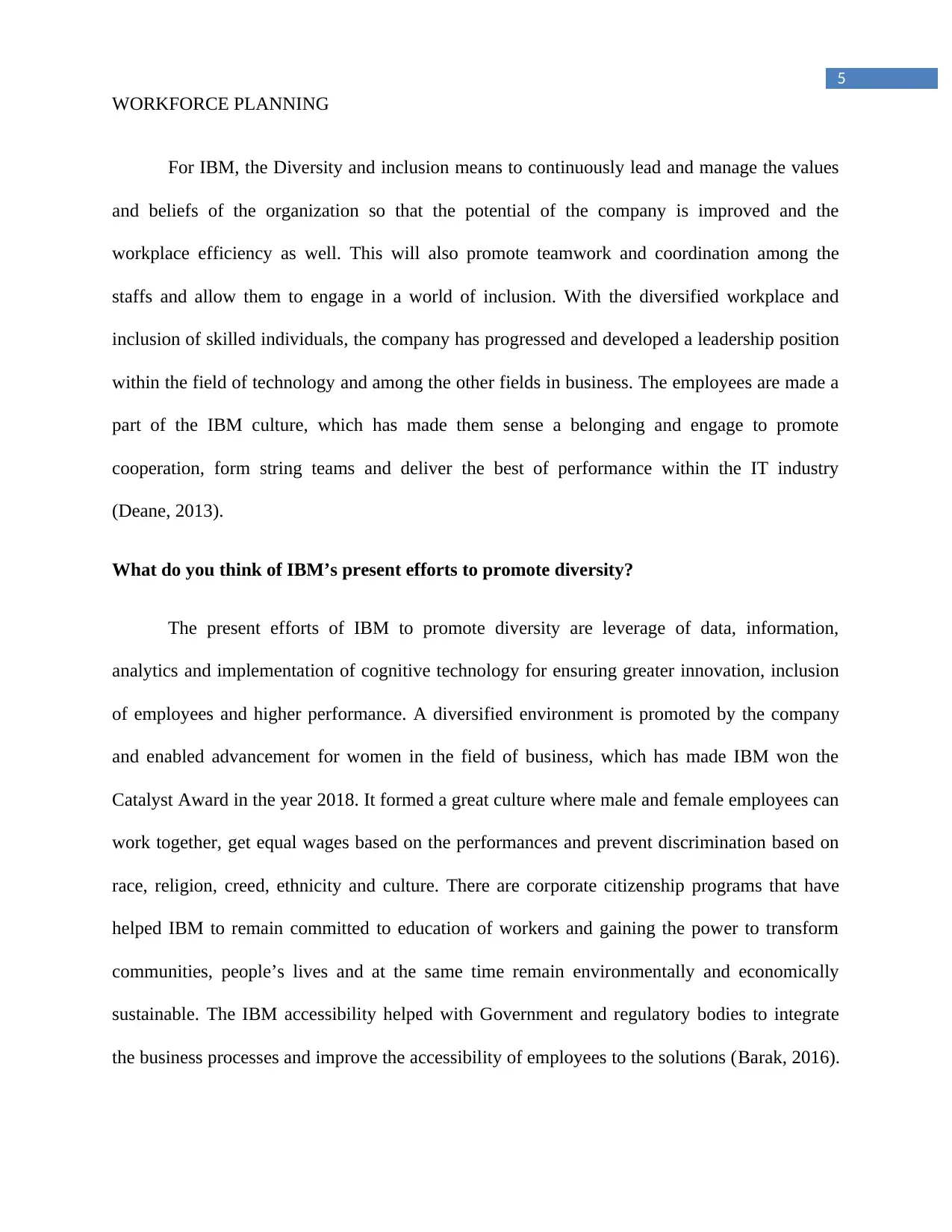
5
WORKFORCE PLANNING
For IBM, the Diversity and inclusion means to continuously lead and manage the values
and beliefs of the organization so that the potential of the company is improved and the
workplace efficiency as well. This will also promote teamwork and coordination among the
staffs and allow them to engage in a world of inclusion. With the diversified workplace and
inclusion of skilled individuals, the company has progressed and developed a leadership position
within the field of technology and among the other fields in business. The employees are made a
part of the IBM culture, which has made them sense a belonging and engage to promote
cooperation, form string teams and deliver the best of performance within the IT industry
(Deane, 2013).
What do you think of IBM’s present efforts to promote diversity?
The present efforts of IBM to promote diversity are leverage of data, information,
analytics and implementation of cognitive technology for ensuring greater innovation, inclusion
of employees and higher performance. A diversified environment is promoted by the company
and enabled advancement for women in the field of business, which has made IBM won the
Catalyst Award in the year 2018. It formed a great culture where male and female employees can
work together, get equal wages based on the performances and prevent discrimination based on
race, religion, creed, ethnicity and culture. There are corporate citizenship programs that have
helped IBM to remain committed to education of workers and gaining the power to transform
communities, people’s lives and at the same time remain environmentally and economically
sustainable. The IBM accessibility helped with Government and regulatory bodies to integrate
the business processes and improve the accessibility of employees to the solutions (Barak, 2016).
WORKFORCE PLANNING
For IBM, the Diversity and inclusion means to continuously lead and manage the values
and beliefs of the organization so that the potential of the company is improved and the
workplace efficiency as well. This will also promote teamwork and coordination among the
staffs and allow them to engage in a world of inclusion. With the diversified workplace and
inclusion of skilled individuals, the company has progressed and developed a leadership position
within the field of technology and among the other fields in business. The employees are made a
part of the IBM culture, which has made them sense a belonging and engage to promote
cooperation, form string teams and deliver the best of performance within the IT industry
(Deane, 2013).
What do you think of IBM’s present efforts to promote diversity?
The present efforts of IBM to promote diversity are leverage of data, information,
analytics and implementation of cognitive technology for ensuring greater innovation, inclusion
of employees and higher performance. A diversified environment is promoted by the company
and enabled advancement for women in the field of business, which has made IBM won the
Catalyst Award in the year 2018. It formed a great culture where male and female employees can
work together, get equal wages based on the performances and prevent discrimination based on
race, religion, creed, ethnicity and culture. There are corporate citizenship programs that have
helped IBM to remain committed to education of workers and gaining the power to transform
communities, people’s lives and at the same time remain environmentally and economically
sustainable. The IBM accessibility helped with Government and regulatory bodies to integrate
the business processes and improve the accessibility of employees to the solutions (Barak, 2016).
⊘ This is a preview!⊘
Do you want full access?
Subscribe today to unlock all pages.

Trusted by 1+ million students worldwide
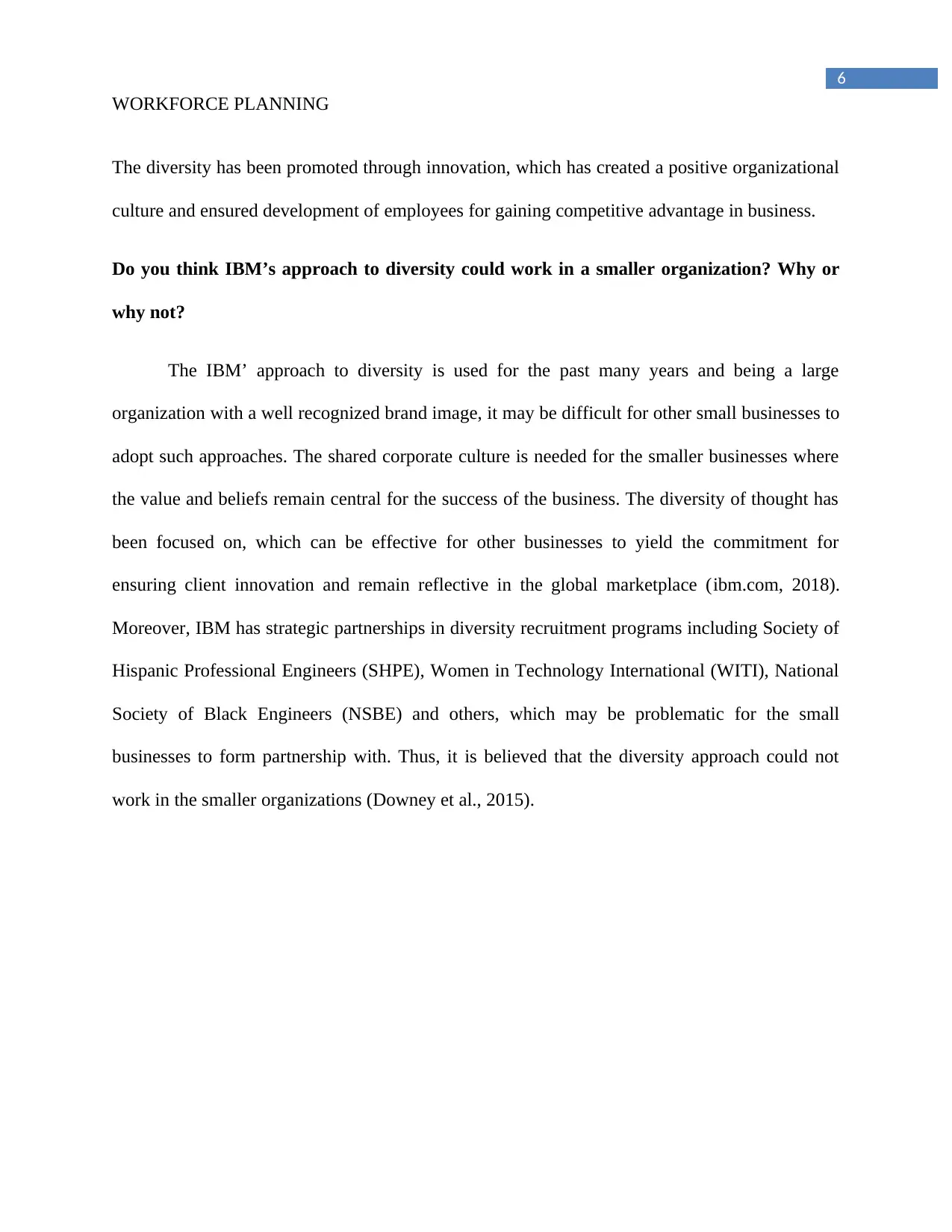
6
WORKFORCE PLANNING
The diversity has been promoted through innovation, which has created a positive organizational
culture and ensured development of employees for gaining competitive advantage in business.
Do you think IBM’s approach to diversity could work in a smaller organization? Why or
why not?
The IBM’ approach to diversity is used for the past many years and being a large
organization with a well recognized brand image, it may be difficult for other small businesses to
adopt such approaches. The shared corporate culture is needed for the smaller businesses where
the value and beliefs remain central for the success of the business. The diversity of thought has
been focused on, which can be effective for other businesses to yield the commitment for
ensuring client innovation and remain reflective in the global marketplace (ibm.com, 2018).
Moreover, IBM has strategic partnerships in diversity recruitment programs including Society of
Hispanic Professional Engineers (SHPE), Women in Technology International (WITI), National
Society of Black Engineers (NSBE) and others, which may be problematic for the small
businesses to form partnership with. Thus, it is believed that the diversity approach could not
work in the smaller organizations (Downey et al., 2015).
WORKFORCE PLANNING
The diversity has been promoted through innovation, which has created a positive organizational
culture and ensured development of employees for gaining competitive advantage in business.
Do you think IBM’s approach to diversity could work in a smaller organization? Why or
why not?
The IBM’ approach to diversity is used for the past many years and being a large
organization with a well recognized brand image, it may be difficult for other small businesses to
adopt such approaches. The shared corporate culture is needed for the smaller businesses where
the value and beliefs remain central for the success of the business. The diversity of thought has
been focused on, which can be effective for other businesses to yield the commitment for
ensuring client innovation and remain reflective in the global marketplace (ibm.com, 2018).
Moreover, IBM has strategic partnerships in diversity recruitment programs including Society of
Hispanic Professional Engineers (SHPE), Women in Technology International (WITI), National
Society of Black Engineers (NSBE) and others, which may be problematic for the small
businesses to form partnership with. Thus, it is believed that the diversity approach could not
work in the smaller organizations (Downey et al., 2015).
Paraphrase This Document
Need a fresh take? Get an instant paraphrase of this document with our AI Paraphraser
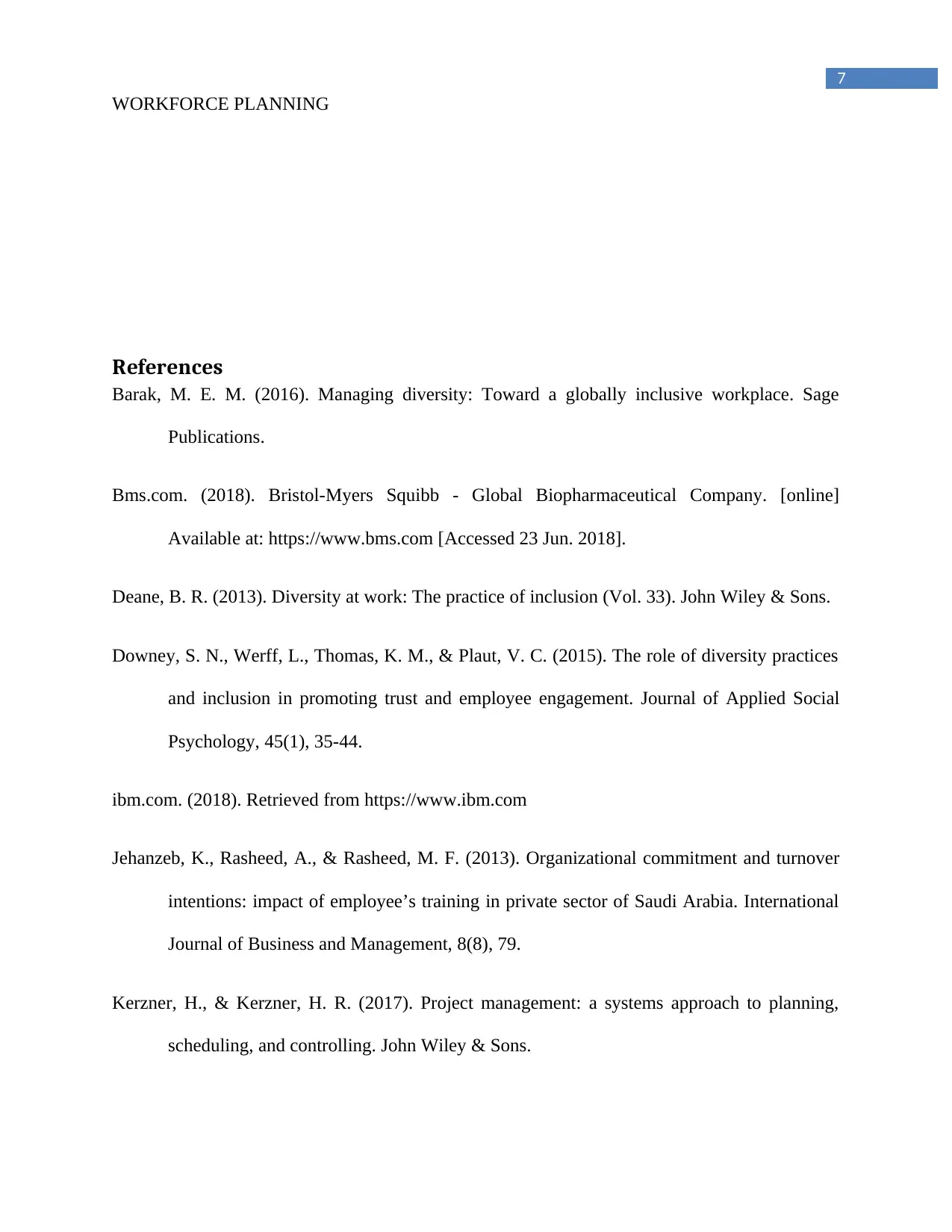
7
WORKFORCE PLANNING
References
Barak, M. E. M. (2016). Managing diversity: Toward a globally inclusive workplace. Sage
Publications.
Bms.com. (2018). Bristol-Myers Squibb - Global Biopharmaceutical Company. [online]
Available at: https://www.bms.com [Accessed 23 Jun. 2018].
Deane, B. R. (2013). Diversity at work: The practice of inclusion (Vol. 33). John Wiley & Sons.
Downey, S. N., Werff, L., Thomas, K. M., & Plaut, V. C. (2015). The role of diversity practices
and inclusion in promoting trust and employee engagement. Journal of Applied Social
Psychology, 45(1), 35-44.
ibm.com. (2018). Retrieved from https://www.ibm.com
Jehanzeb, K., Rasheed, A., & Rasheed, M. F. (2013). Organizational commitment and turnover
intentions: impact of employee’s training in private sector of Saudi Arabia. International
Journal of Business and Management, 8(8), 79.
Kerzner, H., & Kerzner, H. R. (2017). Project management: a systems approach to planning,
scheduling, and controlling. John Wiley & Sons.
WORKFORCE PLANNING
References
Barak, M. E. M. (2016). Managing diversity: Toward a globally inclusive workplace. Sage
Publications.
Bms.com. (2018). Bristol-Myers Squibb - Global Biopharmaceutical Company. [online]
Available at: https://www.bms.com [Accessed 23 Jun. 2018].
Deane, B. R. (2013). Diversity at work: The practice of inclusion (Vol. 33). John Wiley & Sons.
Downey, S. N., Werff, L., Thomas, K. M., & Plaut, V. C. (2015). The role of diversity practices
and inclusion in promoting trust and employee engagement. Journal of Applied Social
Psychology, 45(1), 35-44.
ibm.com. (2018). Retrieved from https://www.ibm.com
Jehanzeb, K., Rasheed, A., & Rasheed, M. F. (2013). Organizational commitment and turnover
intentions: impact of employee’s training in private sector of Saudi Arabia. International
Journal of Business and Management, 8(8), 79.
Kerzner, H., & Kerzner, H. R. (2017). Project management: a systems approach to planning,
scheduling, and controlling. John Wiley & Sons.

8
WORKFORCE PLANNING
Landis, D., & Brislin, R. W. (Eds.). (2013). Handbook of intercultural training: Issues in training
methodology (Vol. 116). Elsevier.
sdmts.com. (2018). Retrieved from https://www.sdmts.com
WORKFORCE PLANNING
Landis, D., & Brislin, R. W. (Eds.). (2013). Handbook of intercultural training: Issues in training
methodology (Vol. 116). Elsevier.
sdmts.com. (2018). Retrieved from https://www.sdmts.com
⊘ This is a preview!⊘
Do you want full access?
Subscribe today to unlock all pages.

Trusted by 1+ million students worldwide
1 out of 9
Related Documents
Your All-in-One AI-Powered Toolkit for Academic Success.
+13062052269
info@desklib.com
Available 24*7 on WhatsApp / Email
![[object Object]](/_next/static/media/star-bottom.7253800d.svg)
Unlock your academic potential
Copyright © 2020–2025 A2Z Services. All Rights Reserved. Developed and managed by ZUCOL.




